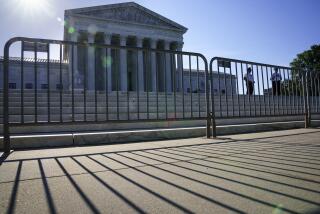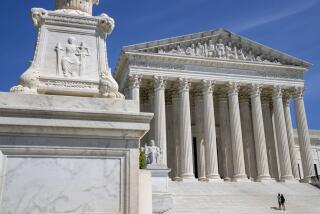Opinion: The best argument for packing the Supreme Court is premature
Speaker Nancy Pelosi did President Biden a favor when she said that she had “no plans” to bring to the floor of the House a proposed expansion of the Supreme Court.
Biden has asked a 36-member commission (four times the number of justices!) to study “the principal arguments in the contemporary public debate for and against Supreme Court reform” — including adding justices — so-called court-packing — or giving justices fixed terms. Moving legislation on the subject before the commission reported would have preempted the commission’s work.
But the debate over expanding the court will continue, and that’s fine. Whether you support enlarging the Supreme Court or oppose it (as I do), it’s worth scrutinizing the arguments for such a momentous change.
Some arguments for court-packing are better than others. Let’s take them in reverse order of seriousness.
The easiest argument to dismiss is one that Rep. Jerrold Nadler (D-N.Y.) cited in announcing the introduction of legislation to add four justices to the court: There should be 13 justices because there are now 13 U.S. Circuit Courts of Appeal.
A bit of explanation: Every Supreme Court justice is also a “circuit justice” for one or more of the federal appeals courts. A circuit justice receives emergency applications from his or her circuit, and often relays them to the entire court.
In the 19th century, Nadler noted, there were nine justices and nine circuits. But now there are 13 circuits, meaning that some justices have to double up. Justice Brett M. Kavanaugh, for example, is responsible for both the 6th and 8th Circuits. (Justice Elena Kagan is the circuit justice for the humongous 9th Circuit, which includes California.)
But being responsible for two circuits doesn’t necessarily mean more work because different circuits can generate different numbers of emergency applications. In any event, Arthur Hellmann, an expert on federal courts at the University of Pittsburgh Law School, notes that the portion of justices’ time taken up by their circuit duties is very small.
Hellmann is equally unimpressed by another argument floated by Nadler: that a larger Supreme Court is necessary because of the proliferation of federal laws.
Nadler said the nine justices were adequate in the 19th century when “many of our most important federal laws — covering everything from civil rights to antitrust, the internet, financial regulation, healthcare, immigration, and white collar crime — simply did not exist, and did not require adjudication by the Supreme Court.”
Now, he suggested, the court’s workload is heavier. Therefore we need a larger court.
Hellman, however, points out that in the 19th century the Supreme Court had to deal with many cases stemming from disputes arising in common law rather than federal statutes. The justices were plenty busy.
Another, marginally more persuasive, argument is that expanding the court is justified payback for the Republicans “stealing” a Supreme Court from Democrats in 2016. That was the year in which then-Senate Majority Leader Mitch McConnell (R-Ky.) refused to consider President Obama’s nomination of Merrick Garland to succeed the late Justice Antonin Scalia. Scalia’s seat eventually went to Neil Gorsuch, a President Trump appointee.
McConnell’s behavior was outrageous, and Republicans added hypocrisy to injury when they confirmed another Trump appointee, Amy Coney Barrett, in 2020 after Justice Ruth Bader Ginsburg died. Never mind McConnell’s insistence after Scalia’s death that in an election year the American people “should have a voice in the selection of their next Supreme Court justice.”
But even if you accept the fact that Republicans “stole” Garland’s seat, that’s still only one seat, and the proposed legislation would add four seats. (The idea that Republicans also stole the Ginsburg seat by confirming Barrett makes sense only if you insist that Supreme Court vacancies shouldn’t be filled in an election year, which decidedly wasn’t the Democrats’ position in 2016.)
Finally, there is one argument for court-packing that does invoke an important principle: that the court as currently constituted poses a threat to democracy, not just to Democratic Party priorities. Or, in the words of Rep. Mondaire Jones (D-N.Y.), another proponent of court enlargement: “Our democracy is hanging by a thread. And the far-right majority on the U.S. Supreme Court is cutting it.” Jones has also said that expanding the court is necessary to “defeat Jim Crow.”
Even some who wouldn’t echo that apocalyptic alarmism fear that the court might strike down a proposed new version of the Voting Rights Act and H.R. 1, the mammoth Democratic bill passed by the House that would allow wide use of mail-in ballots and set a minimum number of days for early voting, among other changes to election law. (That assumes, of course, that bill would pass the Senate.)
Progressives are understandably haunted by the court’s gutting of a key provision in the Voting Rights Act in a 2013 case called Shelby County vs. Holder. But even if you think that case was wrongly decided, it doesn’t mean that the current court would invalidate provisions of H.R. 1 or the John Lewis Voting Rights Amendment Act, a companion piece of legislation that responds to the Shelby County ruling.
Some of the requirements that H.R. 1 would impose on the states seem clearly justified by the text of the Constitution, which allows Congress to override decisions by state legislatures about the “times, places and manner” of congressional elections.
As for the Voting Rights Act, it’s important to remember what the court actually did in the Shelby County case. A 5-4 conservative majority ruled that Congress had used outdated data in deciding which states with a history of racial bias in voting had to “pre-clear” changes in their election practices with the Justice Department or a federal court in Washington, D.C.
Yet that decision left the pre-clearance requirement intact and essentially invited Congress to come up with a new coverage formula more reflective of “current conditions.” That’s just what the John Lewis Voting Voting Rights Advancement Act would do. If the court were to strike that down on a partisan vote, calls for enlarging the court would be more persuasive. But such a decision is far from foreordained.
“Pack the court to save democracy” is a more much appealing argument than “13 justices for 13 circuits” or “Avenge Merrick Garland Times Four.” But it’s also premature. And, like the other arguments for court-packing, it must be weighed against the danger that a partisan enlargement of the court would reinforce the perception that the justices are just “politicians in robes” and tempt Republicans to add even more seats if they regained control of Congress and the White House.
More to Read
A cure for the common opinion
Get thought-provoking perspectives with our weekly newsletter.
You may occasionally receive promotional content from the Los Angeles Times.











